The scientific classification of soils of Kerala is made based on classification system developed by USDA, the Soil Management Support Services. This multicategoric system is known as soil taxonomy. Each category is an aggregate of taxa, defined at about the same level of abstraction with smallest number of classes in the highest category and largest number in the lowest category. These categories are Order, Suborder, Great group, Subgroup, Family and Series. There are 12 orders under the System viz., Gelisols, Histosols, Spodosols, Andisols, Oxisols, Vertisols, Aridisols, Ultisols, Mollisols, Alfisols, Inceptisols and Entisols. Of these, eight orders are encountered in Kerala. They are Histosols, Spodosols, Vertisols, Ultisols, Mollisols, Alfisols, Inceptisols and Entisols.

 There are no large contiguous areas of peats in Kerala. These are organic rich soils with organic matter, Hemists or Saprists that develop in lower topographic positions in a permanent water saturated environment. High acidity and high content of sulphidic material are associated with Histosols. These soils present numerous nutrient management problems and need special management for optimum returns. Cultivation of Histosols with organic layers result in decomposition of organic matter with concomittent shrinkage of soils. Upon shrinkage, the permanent water table comes to the surface and reduces the soil quality. These soils are identified in Kuttanad Kari lands.
There are no large contiguous areas of peats in Kerala. These are organic rich soils with organic matter, Hemists or Saprists that develop in lower topographic positions in a permanent water saturated environment. High acidity and high content of sulphidic material are associated with Histosols. These soils present numerous nutrient management problems and need special management for optimum returns. Cultivation of Histosols with organic layers result in decomposition of organic matter with concomittent shrinkage of soils. Upon shrinkage, the permanent water table comes to the surface and reduces the soil quality. These soils are identified in Kuttanad Kari lands. Spodosols have been identified on the raised coastal sandy beach deposits or the coastal sandy levees in the Alappuzha coastal plains. Further studies are required for establishing the presence of Spodosols in Kerala
Spodosols have been identified on the raised coastal sandy beach deposits or the coastal sandy levees in the Alappuzha coastal plains. Further studies are required for establishing the presence of Spodosols in Kerala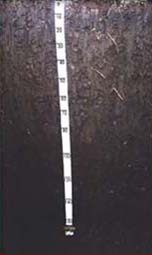 Vertisols in Kerala are confined to the Palghat gap and they extend eastward into Tamil Nadu. Typically, the soil form on 2:1 lattice clays on broad valley bottoms. Internal drainage is usually impeded. These soils have uniform black or dark colour with more than 30% clay which swell on wetting and shrink on drying. This swell-shrink process create wide deep cracks in summer. In the wet season, the soil is very sticky and gets very firm on drying. Both these conditions present problems for maintaining a good tilth. As the soil occurs in depressions, if there is no external drainage outlet, evaporation of soil moisture results in salinity build up. With good management and input of fertilizers, Vertisols are very productive soils capable of producing very high yields of paddy, sugarcane and cotton
Vertisols in Kerala are confined to the Palghat gap and they extend eastward into Tamil Nadu. Typically, the soil form on 2:1 lattice clays on broad valley bottoms. Internal drainage is usually impeded. These soils have uniform black or dark colour with more than 30% clay which swell on wetting and shrink on drying. This swell-shrink process create wide deep cracks in summer. In the wet season, the soil is very sticky and gets very firm on drying. Both these conditions present problems for maintaining a good tilth. As the soil occurs in depressions, if there is no external drainage outlet, evaporation of soil moisture results in salinity build up. With good management and input of fertilizers, Vertisols are very productive soils capable of producing very high yields of paddy, sugarcane and cotton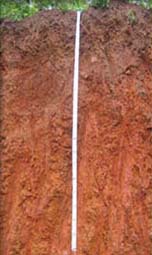 Ultisols are comparable with Alfisols except for having low base saturation due to advanced stages of weathering. These are base-poor mineral soils of humid region developed under high rainfall areas. They have low (35%) base saturation and a clay enriched sub surface horizon. The soils under this order occurs on all kinds of parent material and at varied geomorphic positions. Many of them are formed on pediments and are mostly gravelly. Because of the low fertility and low base status, these soils pose limitations for agricultural use.
Ultisols are comparable with Alfisols except for having low base saturation due to advanced stages of weathering. These are base-poor mineral soils of humid region developed under high rainfall areas. They have low (35%) base saturation and a clay enriched sub surface horizon. The soils under this order occurs on all kinds of parent material and at varied geomorphic positions. Many of them are formed on pediments and are mostly gravelly. Because of the low fertility and low base status, these soils pose limitations for agricultural use.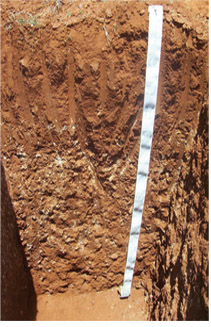 There are small areas of Mollisols in the Western Ghats in rain shadow regions which are predominantly eastern sloping. Low rainfall of 1000mm and less characterise these areas. Mollisols have dark coloured well developed base- rich well-structured surface horizon, rich in organic matter. The subsurface horizon rich in illuviated clay and calcareous materials may be present but not definitive.
There are small areas of Mollisols in the Western Ghats in rain shadow regions which are predominantly eastern sloping. Low rainfall of 1000mm and less characterise these areas. Mollisols have dark coloured well developed base- rich well-structured surface horizon, rich in organic matter. The subsurface horizon rich in illuviated clay and calcareous materials may be present but not definitive.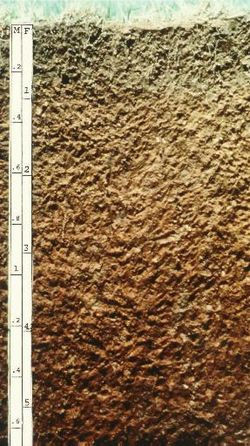 Alfisols are base-rich mineral soils of subhumid and humid regions. Generally, the subsoil contains significant accumulation of illuviated silicate clays. The subsurface horizons are rich in exchangeable cations with high base saturation. These soils are developed from different type of parent material and at varied geomorphic position. Many of them are formed on pediments and are thus stony and gravelly. The soil is suitable for growing a wide variety of crops.
Alfisols are base-rich mineral soils of subhumid and humid regions. Generally, the subsoil contains significant accumulation of illuviated silicate clays. The subsurface horizons are rich in exchangeable cations with high base saturation. These soils are developed from different type of parent material and at varied geomorphic position. Many of them are formed on pediments and are thus stony and gravelly. The soil is suitable for growing a wide variety of crops.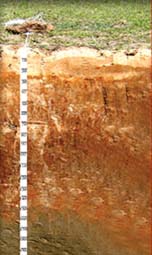 The Inceptisols are juvenile soils developed owing to the alteration of parent material and occupy similar geomorphic positions as that of Entisols. The major difference is that the land form is more stable. On the high terrain, where erosion is not active, soils with thicker solum forms. These are ideal environments for humus accumulation and the soils are generally Dystrustepts. Dystrustepts are also present in the midland lateritic soils. These gravelly to stony soils are heavily eroded and consequently truncated. The normal soils in this geomorphic positions are soils with argillic and kandic horizons, Alfisols and Ultisols which are today degraded as Dystrustepts. Such soils require special attention to prevent degradation. The wet Inceptisols or Aquepts form large tracts of wetlands in Kerala
The Inceptisols are juvenile soils developed owing to the alteration of parent material and occupy similar geomorphic positions as that of Entisols. The major difference is that the land form is more stable. On the high terrain, where erosion is not active, soils with thicker solum forms. These are ideal environments for humus accumulation and the soils are generally Dystrustepts. Dystrustepts are also present in the midland lateritic soils. These gravelly to stony soils are heavily eroded and consequently truncated. The normal soils in this geomorphic positions are soils with argillic and kandic horizons, Alfisols and Ultisols which are today degraded as Dystrustepts. Such soils require special attention to prevent degradation. The wet Inceptisols or Aquepts form large tracts of wetlands in Kerala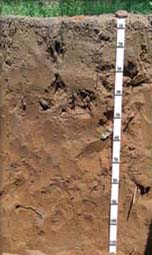 Entisols lack diagnostic horizons and occur on plains of recent to sub recent deposits and on steep aspects of the hilly terrain. In the steep slopes of the Western Ghats, soils are often truncated due to severe erosion losses. Young soils with very less profile development are also encountered in high altitude mountain summits. These are fragile soils and must be retained under their natural vegetation. The second group of Entisols occur on the narrow banks of the rivers and coastal plains. Depending on the mode of deposition, the texture varies from clay to sand. Fluvents and Psamments are the dominant soils. Organic material is also present in pockets, some times as buried horizons. The Aquents are frequently inundated or permanently saturated with water and show signs of wetness
Entisols lack diagnostic horizons and occur on plains of recent to sub recent deposits and on steep aspects of the hilly terrain. In the steep slopes of the Western Ghats, soils are often truncated due to severe erosion losses. Young soils with very less profile development are also encountered in high altitude mountain summits. These are fragile soils and must be retained under their natural vegetation. The second group of Entisols occur on the narrow banks of the rivers and coastal plains. Depending on the mode of deposition, the texture varies from clay to sand. Fluvents and Psamments are the dominant soils. Organic material is also present in pockets, some times as buried horizons. The Aquents are frequently inundated or permanently saturated with water and show signs of wetness

